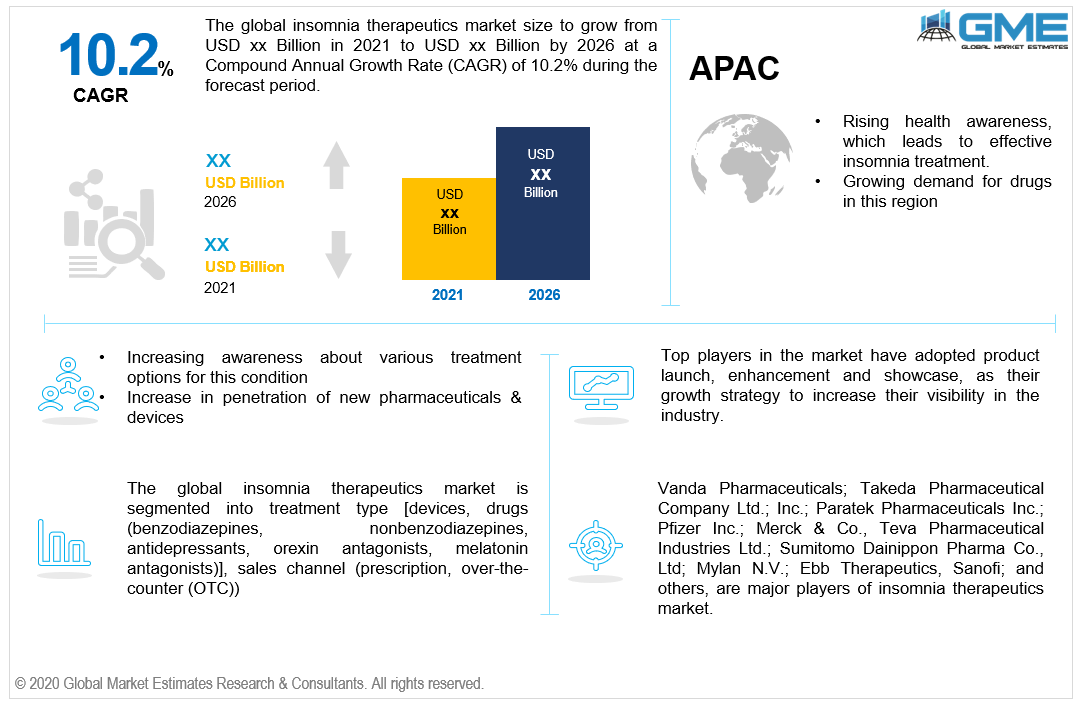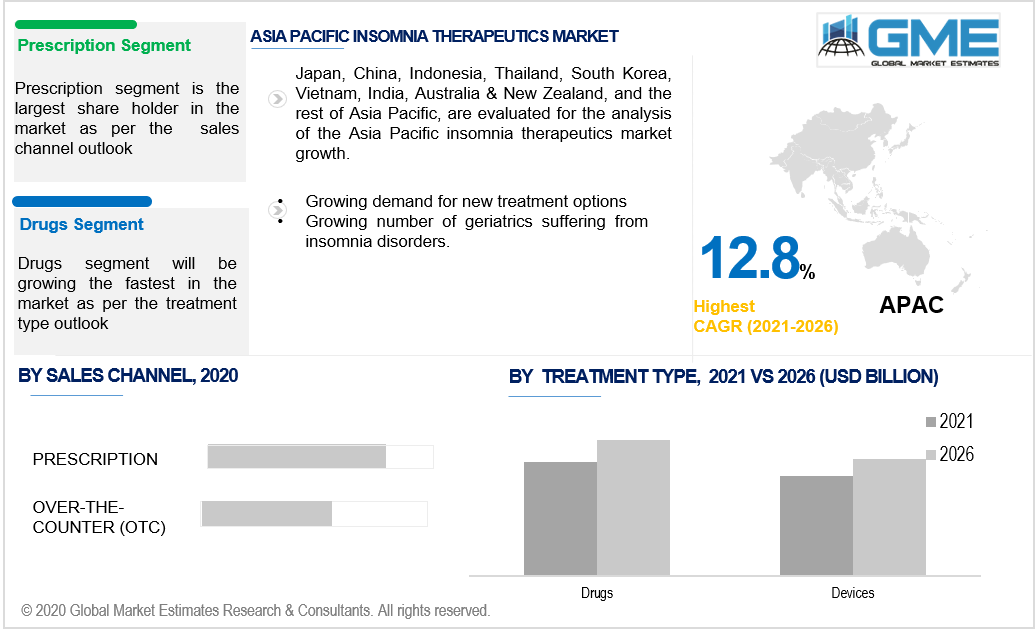
Global Insomnia Therapeutics Market Size, Trends, and Analysis - Forecasts To 2026 By Treatment Type [Devices, Drugs (Benzodiazepines, Nonbenzodiazepines, Antidepressants, Orexin Antagonists, Melatonin Antagonists)], By Sales Channel (Prescription, Over-the-Counter (OTC)), By Region (North America, Asia Pacific, CSA, Europe, and the Middle East and Africa); End-User Landscape, Company Market Share Analysis & Competitor Analysis
Insomnia is described as insufficient sleep or non-restorative sleep, which can be induced by stress or the use of certain drugs or pharmaceuticals. A primary poor sleep or a mental disease can cause long-term insomnia. Insomnia is a serious problem during the day because it disrupts everyday activities and can cause aggravation, and also a lack of awareness, which contributes to a rise in the proportion of accidents. Insomnia could also be caused by rising stressful factors like job loss, family conflict, or the death of a dear one. Insomnia is more prevalent in adults than in the young, owing to pharmacological side effects related to the diagnosis of chronic illnesses.
For treatment of both short and long-term insomnia, numerous medications have been offered. Zolpidem, Benzodiazepines, Zaleplon, Trazodone, Tricyclic Antidepressants, and various new-generation antidepressants, are the most often used drugs for therapy. The benzodiazepine class of medicines is widely prescribed for active people & the elderly as they are readily excreted from the body. Myorelaxants, which also have anxiolytic characteristics, is another kind of insomnia drug. The usage of these medications over an extended period might lead to addiction and dependency. As a result, these medications must be given under medical prescription.
The main reason driving the expansion of this marketplace is a rise in the aging population, an augment in the proportion of mental illnesses, rising anxiety levels among the youngsters, and also an augment in chronic and long-term diseases like Parkinson's disease, Alzheimer's, and, cancer, which need sedatives as one of the drugs prescribed. The industry is predicted to rise with the advancement of technological developments and the launch of medical equipment. Medical devices, like Alpha-Stim AID, Fisher Wallace Stimulator, & EBB Insomnia Therapy, were approved in past years, and they are anticipated to have a larger penetration due to the usage of a combination of tool and pharmacological therapy for curing insomnia The augmented usage of novel drugs and technology is estimated to enhance demand for insomnia disorder therapeutic market. Approximately 9 million individuals who've been cured with drugs are still disappointed with the outcome. Devices, or a combination of medications and devices, were shown to provide positive outcomes. Over the forthcoming years, potential benefits from the combination of devices and pharmaceuticals are anticipated to fuel revenue growth in the insomnia treatments market.

Based on the treatment type, the insomnia therapeutics market segment is divided into devices, and drugs which are further sub-divided into benzodiazepines, nonbenzodiazepines, antidepressants, orexin antagonists, and melatonin antagonists. During the projection period, the drug category is predicted to contain a substantial influence on the market.
The drugs category contains both patented and generic medications. In developed nations, patented pharmaceuticals contribute the majority of revenue. Generics and branded generics generated the most revenue in emerging and undeveloped nations. The prevalence of a price-sensitive populace in developing and undeveloped nations, and also the high cost of patented drugs, are the main causes for this gap. Because of its efficacy and accessibility, zolpidem accounts for roughly 70% of all insomnia therapy drugs.
Based on the sales channel, the insomnia therapeutics market segment is divided into prescription, and over-the-counter (OTC). Because of increased patient awareness, there’s been a paradigm change in the global demand for insomnia treatments. In 2019, the prescription category accounted for the most revenue, accounting for roughly 79.2 percent of overall market sales. Owing to a growth in the usage of prescription pharmaceuticals, this category is projected to continue its dominance during the forecast timeframe.
Tryptophan, diphenhydramine, & melatonin are among the active ingredients in OTC therapies. The introduction of innovative therapies with fewer side effects is expected to boost revenues of these treatments. Furthermore, because OTC medications do not necessitate a prescription, they are readily available to patients diagnosed with severe insomnia or those in the early stages of the disease. The market for OTC products is predicted to rise as the proportion of such patients rises.

As per the geographical analysis, the market can be classified into North America (the United States, Canada, and Mexico), Asia Pacific (India, China, Japan, Malaysia, Singapore, and Rest of Asia Pacific), Europe (Germany, United Kingdom, Italy, France, Spain, Netherlands, and Rest of Europe), Middle East & Africa (Saudi Arabia, United Arab Emirates, and Rest of the Middle East & Africa) and Central & South America (Brazil, Argentina, and Rest of Central and South America). During the forecast timeframe, the North American region is expected to dominate the global economy. Over the forecast period, Asia Pacific is expected to grow at a rapid pace.
Vanda Pharmaceuticals; Takeda Pharmaceutical Company Ltd. Inc.; Paratek Pharmaceuticals Inc.; Pfizer Inc.; Merck & Co., Teva Pharmaceutical Industries Ltd.; Sumitomo Dainippon Pharma Co., Ltd; Mylan N.V.; Ebb Therapeutics, and Sanofi; among others, are major players of insomnia therapeutics market.
Please note: This is not an exhaustive list of companies profiled in the report.
Chapter 1 Methodology
1.1 Market Scope & Definitions
1.2 Estimates & Forecast Calculation
1.3 Historical Data Overview And Validation
1.4 Data Sources
1.4.1 Secondary
1.4.2 Primary
Chapter 2 Report Outlook
2.1 Global Insomnia Therapeutics Industry Overview, 2016-2026
2.1.1 Industry Overview
2.1.2 Product Overview
2.1.3 Type Overview
2.1.4 Regional Overview
Chapter 3 Insomnia Therapeutics Market Trends
3.1 Market Segmentation
3.2 Industry Background, 2016-2026
3.3 Market Key Trends
3.3.1 Positive Trends
3.3.1.1 Technological advances in medical devices for insomnia.
3.3.1.2 Presence of potential clinical pipeline candidates for insomnia.
3.3.2 Industry Challenges
3.3.2.1 Lower diagnosis rate, low treatment rate and high number of dis-satisfied patients.
3.4 Prospective Growth Scenario
3.5 COVID-19 Influence over Industry Growth
3.6 Porter’s Analysis
3.7 PESTEL Analysis
3.7 Value Chain & Supply Chain Analysis
3.9 Regulatory Framework
3.9.1 North America
3.9.2 Europe
3.9.3 APAC
3.9.4 LATAM
3.9.5 MEA
3.10 Technology Overview
3.11 Market Share Analysis, 2020
3.11.1 Company Positioning Overview, 2020
Chapter 4 Global Insomnia Therapeutics Market, By Treatment Type
4.1 Treatment Type Outlook
4.2 Drugs
4.2.1 Market Size, By Region, 2016-2026 (USD Billion)
4.2 Devices
4.2.1 Market Size, By Region, 2016-2026 (USD Billion)
Chapter 5 Global Insomnia Therapeutics Market, By Sales Channel
5.1 Sales Channel Outlook
5.2 Prescription
5.2.1 Market Size, By Region, 2016-2026 (USD Billion)
5.2 Over-the-Counter (OTC)
5.2.1 Market Size, By Region, 2016-2026 (USD Billion)
Chapter 6 Global Insomnia Therapeutics Market, By Region
6.1 Regional outlook
6.2 North America
6.2.1 Market Size, By Country 2016-2026 (USD Billion)
6.2.2 Market Size, By Treatment Type, 2016-2026 (USD Billion)
6.2.3 Market Size, By Sales Channel, 2016-2026 (USD Billion)
6.2.4 U.S.
6.2.4.1 Market Size, By Treatment Type, 2016-2026 (USD Billion)
6.2.4.2 Market Size, By Sales Channel, 2016-2026 (USD Billion)
6.2.5 Canada
6.2.5.1 Market Size, By Treatment Type, 2016-2026 (USD Billion)
6.2.5.2 Market Size, By Sales Channel, 2016-2026 (USD Billion)
6.3 Europe
6.3.1 Market Size, By Country 2016-2026 (USD Billion)
6.3.2 Market Size, By Treatment Type, 2016-2026 (USD Billion)
6.3.3 Market Size, By Sales Channel, 2016-2026 (USD Billion)
6.3.4 Germany
6.3.4.1 Market Size, By Treatment Type, 2016-2026 (USD Billion)
6.2.4.2 Market Size, By Sales Channel, 2016-2026 (USD Billion)
6.3.5 UK
6.3.5.1 Market Size, By Treatment Type, 2016-2026 (USD Billion)
6.3.5.2 Market Size, By Sales Channel, 2016-2026 (USD Billion)
6.3.6 France
6.3.6.1 Market Size, By Treatment Type, 2016-2026 (USD Billion)
6.3.6.2 Market Size, By Sales Channel, 2016-2026 (USD Billion)
6.3.7 Italy
6.3.7.1 Market Size, By Treatment Type, 2016-2026 (USD Billion)
6.3.7.2 Market Size, By Sales Channel, 2016-2026 (USD Billion)
6.3.8 Spain
6.3.8.1 Market Size, By Treatment Type, 2016-2026 (USD Billion)
6.3.8.2 Market Size, By Sales Channel, 2016-2026 (USD Billion)
6.3.9 Russia
6.3.9.1 Market Size, By Treatment Type, 2016-2026 (USD Billion)
6.3.9.2 Market Size, By Sales Channel, 2016-2026 (USD Billion)
6.4 Asia Pacific
6.4.1 Market Size, By Country 2016-2026 (USD Billion)
6.4.2 Market Size, By Treatment Type, 2016-2026 (USD Billion)
6.4.3 Market Size, By Sales Channel, 2016-2026 (USD Billion)
6.4.4 China
6.4.4.1 Market Size, By Treatment Type, 2016-2026 (USD Billion)
6.4.4.2 Market Size, By Sales Channel, 2016-2026 (USD Billion)
6.4.5 India
6.4.5.1 Market Size, By Treatment Type, 2016-2026 (USD Billion)
6.4.5.2 Market Size, By Sales Channel, 2016-2026 (USD Billion)
6.4.6 Japan
6.4.6.1 Market Size, By Treatment Type, 2016-2026 (USD Billion)
6.4.6.2 Market Size, By Sales Channel, 2016-2026 (USD Billion)
6.4.7 Australia
6.4.7.1 Market Size, By Treatment Type, 2016-2026 (USD Billion)
6.4.7.2 Market size, By Sales Channel, 2016-2026 (USD Billion)
6.4.8 South Korea
6.4.8.1 Market Size, By Treatment Type, 2016-2026 (USD Billion)
6.4.8.2 Market Size, By Sales Channel, 2016-2026 (USD Billion)
6.5 Latin America
6.5.1 Market Size, By Country 2016-2026 (USD Billion)
6.5.2 Market Size, By Treatment Type, 2016-2026 (USD Billion)
6.5.3 Market Size, By Sales Channel, 2016-2026 (USD Billion)
6.5.4 Brazil
6.5.4.1 Market Size, By Treatment Type, 2016-2026 (USD Billion)
6.5.4.2 Market Size, By Sales Channel, 2016-2026 (USD Billion)
6.5.6 Mexico
6.5.6.1 Market Size, By Treatment Type, 2016-2026 (USD Billion)
6.5.6.2 Market Size, By Sales Channel, 2016-2026 (USD Billion)
6.5.7 Argentina
6.5.7.1 Market Size, By Treatment Type, 2016-2026 (USD Billion)
6.5.7.2 Market Size, By Sales Channel, 2016-2026 (USD Billion)
6.8 MEA
6.8.1 Market Size, By Country 2016-2026 (USD Billion)
6.8.2 Market Size, By Treatment Type, 2016-2026 (USD Billion)
6.8.3 Market Size, By Sales Channel, 2016-2026 (USD Billion)
6.8.4 Saudi Arabia
6.8.4.1 Market Size, By Treatment Type, 2016-2026 (USD Billion)
6.8.4.2 Market Size, By Sales Channel, 2016-2026 (USD Billion)
6.8.5 UAE
6.8.5.1 Market Size, By Treatment Type, 2016-2026 (USD Billion)
6.8.5.2 Market Size, By Sales Channel, 2016-2026 (USD Billion)
6.8.6 South Africa
6.8.6.1 Market Size, By Treatment Type, 2016-2026 (USD Billion)
6.8.6.2 Market Size, By Sales Channel, 2016-2026 (USD Billion)
Chapter 7 Company Landscape
7.1 Competitive Analysis, 2020
7.2 Takeda Pharmaceutical Company Ltd.
7.2.1 Company Overview
7.2.2 Financial Analysis
7.2.3 Strategic Positioning
7.2.4 Info-Graphic Analysis
7.3 Vanda Pharmaceuticals Inc.
7.3.1 Company Overview
7.3.2 Financial Analysis
7.3.3 Strategic Positioning
7.3.4 Info-Graphic Analysis
7.4 Merck & Co.
7.4.1 Company Overview
7.4.2 Financial Analysis
7.4.3 Strategic Positioning
7.4.4 Info-Graphic Analysis
7.5 Mylan N.V.
7.5.1 Company Overview
7.5.2 Financial Analysis
7.5.3 Strategic Positioning
7.5.4 Info-Graphic Analysis
7.6 Pfizer Inc.
7.6.1 Company Overview
7.6.2 Financial Analysis
7.6.3 Strategic Positioning
7.6.4 Info-Graphic Analysis
7.7 Teva Pharmaceutical Industries Ltd..
7.7.1 Company Overview
7.7.2 Financial Analysis
7.7.3 Strategic Positioning
7.7.4 Info-Graphic Analysis
7.8 Sumitomo Dainippon Pharma Co., Ltd.
7.8.1 Company Overview
7.8.2 Financial Analysis
7.8.3 Strategic Positioning
7.8.4 Info-Graphic Analysis
7.9 Sanofi S.A.
7.9.1 Company Overview
7.9.2 Financial Analysis
7.9.3 Strategic Positioning
7.9.4 Info-Graphic Analysis
7.10 Paratek Pharmaceuticals, Inc.
7.10.1 Company Overview
7.10.2 Financial Analysis
7.10.3 Strategic Positioning
7.10.4 Info-Graphic Analysis
7.11 Ebb Therapeutics
7.11.1 Company Overview
7.11.2 Financial Analysis
7.11.3 Strategic Positioning
7.11.4 Info-Graphic Analysis
7.12 Other Companies
7.12.1 Company Overview
7.12.2 Financial Analysis
7.12.3 Strategic Positioning
7.12.4 Info-Graphic Analysis
The Global Insomnia Therapeutics Market has been studied from the year 2019 till 2026. However, the CAGR provided in the report is from the year 2021 to 2026. The research methodology involved three stages: Desk research, Primary research, and Analysis & Output from the entire research process.

The desk research involved a robust background study which meant referring to paid and unpaid databases to understand the market dynamics; mapping contracts from press releases; identifying the key players in the market, studying their product portfolio, competition level, annual reports/SEC filings & investor presentations; and learning the demand and supply-side analysis for the Insomnia Therapeutics Market.

The primary research activity included telephonic conversations with more than 50 tier 1 industry consultants, distributors, and end-use product manufacturers.

Finally, based on the above thorough research process, an in-depth analysis was carried out considering the following aspects: market attractiveness, current & future market trends, market share analysis, SWOT analysis of the company and customer analytics.

Frequently Asked Questions
Tailor made solutions just for you
80% of our clients seek made-to-order reports. How do you want us to tailor yours?
OUR CLIENTS